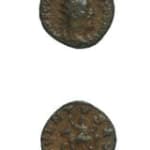Silver Antoninianus of Emperor Trebonianus Gallus, 251 CE - 253 CE
Silver
C.4486
Obverse: IMP C C VIB TREB GALLVS AVG; Radiate, Draped, and Cuirassed Bust of the Emperor Facing Righ Reverse: ADVENTVS AVG; Gallus on Horseback, Riding to the Left, Carrying a...
Obverse: IMP C C VIB TREB GALLVS AVG; Radiate, Draped, and Cuirassed Bust of the Emperor Facing Righ
Reverse: ADVENTVS AVG; Gallus on Horseback, Riding to the Left, Carrying a Staf
Gaius Vibius Trebonianus Gallus was born into a distinguished Etruscan family from Perugia and would grow to serve as a Roman Senator and Consul. By 250 A.D., Gallus was the legate of Lower Moesia where he commanded the troops of Emperor Trajan Decius in battle against the Goths. After suffering a crushing defeat in which the Emperor was killed, the shattered troops hailed Gallus as the new Augustus. Acting as Emperor, Gallus swiftly arranged a peace treaty with the Goths highly unfavorably to the Empire and rushed back to Rome where he was confirmed by the Senate. Gallus set up court in Rome and adopted Hostilian, the younger son of Decius, as co-Augustus and his own son Volusian was made Caesar. However, soon after, a severe bout of the plague broke out that would ravage the city for fifteen year, claiming the life of Hostilian in November of 251 A.D., at which time Volusian was elevated to the rank of Augustus. Meanwhile, with the borders threatened by Gothic incursions and Persian advances, the successor of Gallus in Lower Moesia, Aemilianus, coordinated a successful punitive expedition against the northern Danubian Goths. Ecstatic over the victory, the Danubian Legions raised Aemilianus up as emperor and his forces quickly marched into Italy where they met Gallus and his loyalist army in Umbria. On the eve of the impending battle, his troops, sensing their inferiority in numbers and recognizing an inevitable defeat, mutinied and murdered Gallus and Volusian in May of 253 A.D.
How many hands have touched a coin in your pocket or purse? What eras and lands have the coin traversed on its journey into our possession? As we reach into our pockets to pull out some change, we rarely hesitate to think of who might have touched the coin before us, or where the coin will venture to after it leaves our hands. More than money, coins are a symbol of the state that struck them, of a specific time and location, whether contemporary currencies or artifacts of a long forgotten empire. This stunning hand-struck coin reveals an expertise of craftsmanship and intricate sculptural detail that is often lacking in contemporary machine-made currencies. This ancient coin is a memorial to an emperor’s brief reign passed from the hands of civilization to civilization, from generation to generation that still appears as vibrant today as the day it was struck.
Reverse: ADVENTVS AVG; Gallus on Horseback, Riding to the Left, Carrying a Staf
Gaius Vibius Trebonianus Gallus was born into a distinguished Etruscan family from Perugia and would grow to serve as a Roman Senator and Consul. By 250 A.D., Gallus was the legate of Lower Moesia where he commanded the troops of Emperor Trajan Decius in battle against the Goths. After suffering a crushing defeat in which the Emperor was killed, the shattered troops hailed Gallus as the new Augustus. Acting as Emperor, Gallus swiftly arranged a peace treaty with the Goths highly unfavorably to the Empire and rushed back to Rome where he was confirmed by the Senate. Gallus set up court in Rome and adopted Hostilian, the younger son of Decius, as co-Augustus and his own son Volusian was made Caesar. However, soon after, a severe bout of the plague broke out that would ravage the city for fifteen year, claiming the life of Hostilian in November of 251 A.D., at which time Volusian was elevated to the rank of Augustus. Meanwhile, with the borders threatened by Gothic incursions and Persian advances, the successor of Gallus in Lower Moesia, Aemilianus, coordinated a successful punitive expedition against the northern Danubian Goths. Ecstatic over the victory, the Danubian Legions raised Aemilianus up as emperor and his forces quickly marched into Italy where they met Gallus and his loyalist army in Umbria. On the eve of the impending battle, his troops, sensing their inferiority in numbers and recognizing an inevitable defeat, mutinied and murdered Gallus and Volusian in May of 253 A.D.
How many hands have touched a coin in your pocket or purse? What eras and lands have the coin traversed on its journey into our possession? As we reach into our pockets to pull out some change, we rarely hesitate to think of who might have touched the coin before us, or where the coin will venture to after it leaves our hands. More than money, coins are a symbol of the state that struck them, of a specific time and location, whether contemporary currencies or artifacts of a long forgotten empire. This stunning hand-struck coin reveals an expertise of craftsmanship and intricate sculptural detail that is often lacking in contemporary machine-made currencies. This ancient coin is a memorial to an emperor’s brief reign passed from the hands of civilization to civilization, from generation to generation that still appears as vibrant today as the day it was struck.
3
of
3



